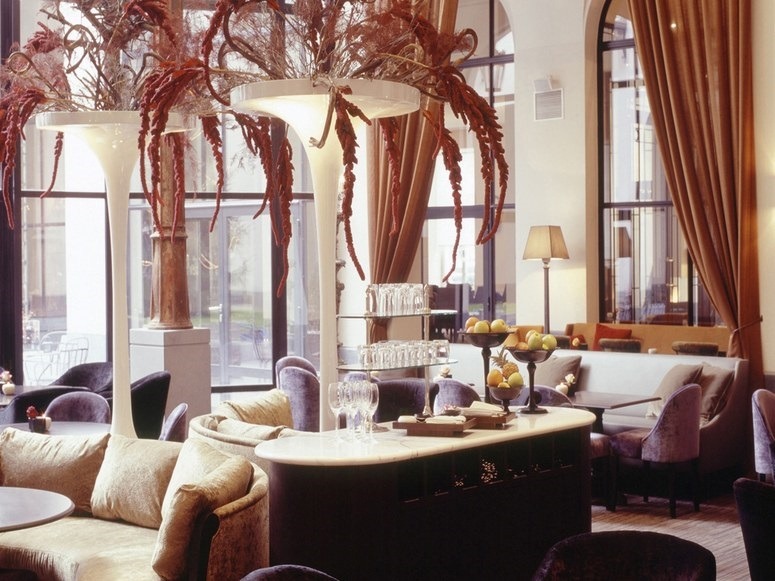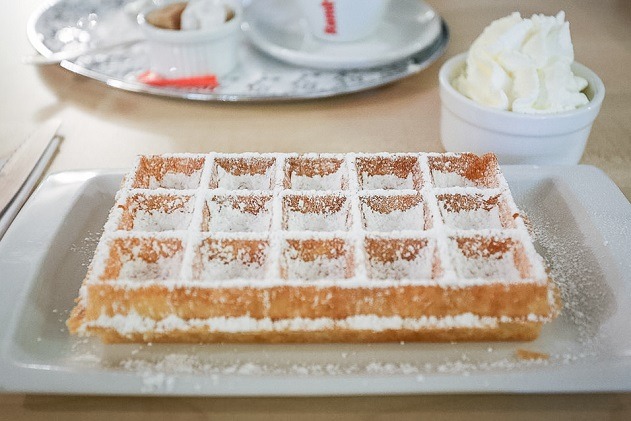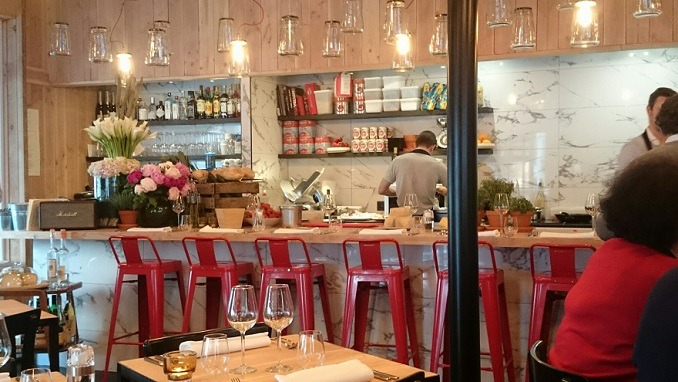Let’s face it: everything revolves around food and drink when we socialise, be it in a restaurant for a business meeting or in a bar with friends. With this issue, The Brussels Times inaugurates “The Belgian Gourmet Corner”, a section devoted to making your life in Brussels tastier, livelier and more engaging. This first edition is made up of four chapters: a great bar, a top-notch bistro, a classic local dish and a surprising local drink. Our new food writer, Hughes Belin, leads us through a tour of the best local eateries and shares his stories about these special places and platters. Enjoy, this summer and beyond!
The Bar: The Dominican
I can’t help it, but as a journalist I dream of one day interviewing a world-famous movie star or an iconic startup CEO in a luxury hotel bar, as depicted in those sleek American magazines. In expectation of that moment, I practice by having meetings in beautiful bars, and I realise that a bit of star magic rubs off during my conversations. Why do we meet in bars, after all? Certainly not to have to shout in order to be heard, or to be surrounded by too loud music and unappealing behavior. Quietness is essential. And the décor should be just right. It has to be special, cosy and tasteful, not ostentatious. And if the bar is located in a building with a bit of history, your checklist of the perfect spot to meet conforms to your expectations.
That is why I choose the bar of the Dominican Hotel for my summer meetings. Of course, you pay a little bit more than in other bars. But this is nothing compared to what you get in return. The owners have managed to keep an atmosphere befitting a Dominican abbey of the 15th century. It is totally isolated from the rest of the city. And yes, you are in the privileged world of the happy few. You have your pick of tables: the lounge, the hotel lobby, the restaurant lobby, a sheltered terrace or outdoor one. The external area is in fact a patio with a fig tree at the centre, ringed by a high-ceilinged cloister. The service is very professional, of course. The bar has a rather conservative wine list, but at least it caters to all tastes. And in such a place, you would probably rather have a cocktail anyway: whether you choose from the barman’s list or opt for a classic, you are in good hands.
There are many bars to choose from in Brussels, from the indigenous “brown cafés” to carefully designed hipster hangouts, including rooftop bars. But the ground floor of the Dominican gives you the thrill of experiencing an exclusive place, an urban sanctuary, a hidden gem in the busy and scruffy area around the Opera de la Monnaie, next to Brussels’ city-centre pedestrian zone.
The Dominican - Rue Leopold 9, 1000 Brussels. Metro De Brouckère
The Beverage: Domaine de Mellemont rosé
Every year around the same time, when the weather starts getting warmer, I have a thirst for rosé wine. It’s time for a BBQ! Yes, the BBQ is a great Belgian tradition. When I first arrived in the country, I always had problems starting one. It would take me several attempts to light up the charcoal and only after exhausting myself blowing at the embers, could I finally enjoy a meal with my starving guests. Then I heard that Belgians are BBQ champions. Simple logic would explain why. All Belgian families send their kids to the Scouts, where they learn the basics of campfires and BBQs, even under the harshest conditions. This is why legend has it that if you give a lighter, charcoal and a Jupiler to any Belgian, he could set up a BBQ in minutes, even in heavy rain, another Belgian tradition.
But I won’t celebrate the famous Belgian pils to accompany my BBQ. I started talking about Belgian rosé wine. Yes, Belgium produces many great wines these days, thanks to the well-publicised climate change. If you have never tasted Belgian wine, a rosé will be a great gateway to the country’s wine selection this summer. But which one to choose? To be honest, I’m as lost as you are when I go to a supermarket to buy a rosé. They all look the same, and very few of them are worthy of your grilled meat, not to mention your guests.
For a BBQ, I would go for a dry rosé, with some structure to match the meat, but enough delicacy to be enjoyable as such. My old friend John Collijs, whom I got to know at the CERIA school in Brussels when we were studying wine, is now THE expert on Belgian wines, his life's passion. He recommended me a great rosé from Domaine de Mellemont in Brabant Wallon at Thorembais-les-Béguines, between Brussels and Namur. The Rosé des Béguines is 45% Müller-Thurghau, 45% Pinot Auxerrois and 10% Pinot Noir (yes, you can make rosé from a blend of white and red grapes in Belgium). The first brings crispiness and body, the second an array of delicate floral aromas and finesse, and the third (red) grape gives it its light pink colour, structure and a strawberry tang. The result is a very classy dry rosé wine with a long finish, definitely worth pairing with grilled meat and accompanying dishes.
One of the Domaine de Mellemont's top fans is Sang Hoon Degeimbre, the chef at the Michelin-starred San and San Sablon in Brussels. “Serious wines which don’t take themselves too seriously”, he calls them. Belgium may not get as much sun as more southern latitudes, but the country is starting to be a real contender among European wine producing countries.
You can buy this rosé wine on-site or online at lesvinsbelges.be for €9.50 a bottle
The Food: Brussels Waffle
One of the most essential facts any newcomer learns about Belgium is the difference between the Brussels and Liège waffles. The first, also known as "the Belgian waffle" in New York ever since the 1964 World Fair, is rectangular, light and crispy whereas its Liège counterpart is oval-shaped and bulky, with pieces of candy sugar inside. Both can be found everywhere in Belgium. But when you talk to connoisseurs about the Brussels waffle, they will tell you that it is almost impossible to find a proper one in Brussels – the best ones are to be found on the Belgian coast. Its name was used for the first time in 1874 by a famous Belgian author on gastronomy, Philippe Edouard Cauderlier, although the recipe already existed in every Belgian family and was transferred from one generation to another. There are plenty of recipes on the Internet, but I found a great one: it won a waffle contest in New York in 2012. It also won in Brussels the same year, during the city’s Year of Gastronomy. The winning team's leader, Carla Dejonghe, chairs the Council of the Flemish Community Commission (read: Brussels’ Dutch-speaking Parliament). She merged her mother’s recipe with others from great chefs to obtain “the lightest possible waffle” (see box).
Yes, a great Brussels waffle must be crispy on the outside and slightly moist inside, freshly cooked and served still warm, straight from the waffle iron. Its squares (15, 20 or 24), must be regular. Originally it was served just with powdered sugar. My colleague Eric Boschman says in his book Le goût des Belges (Belgian Tastes) that “the white rain, which decorated the jacket’s collar and fingertips, was part of its charm”.
Slow Food chef and consultant Catherine Piette, born in the heart of Brussels, is however not against topping it with a klouche (a dollop in Brussels’ dialect) of whipped cream. Of course, you can also add Schaerbeek cherries (sour cherries) cooked in Kriek bier, or top it with speculoos cream, like Carla and her team did. But perhaps the best way to try it for the first time is to stay simple, like a pizza connoisseur tasting a plain margherita pizza.
So where do we find the best Brussels waffles in its namesake city? It looks like your safest bet is the great Belgian biscuit shop, Dandoy’s, next to the Grand Place. They are also good at Zizi, a famous ice cream outlet in Uccle. Some restaurants occasionally add it to their menu, but “it should be street food”, according to Olivier Marette from Visit.Brussels. He likes to eat them at the Foire du Midi, Brussels' annual summer fair (15 July - 20 August this year) between Porte de Hal and Porte d’Anderlecht, next to the Midi station). The Van Dongen truck is also on his short list. Unless of course you prefer to head to the sea for an excellent one at Aan Zee in De Panne or a gigantic one at Silversand in Blankenberge.
| A winning recipe For those, like Carla Dejonghe, who prefer to bake them at home”, here is her exclusive recipe, which won awards in Brussels and New York. Ingredients: 450g self-rising flour; 150g butter; 20g fresh yeast; 3 eggs; 375ml full fat milk; 375ml sparkling water; one tsp vanilla sugar; a pinch of salt. Method: Separate egg yolks and whites. Lightly beat the yolks with the vanilla sugar. Melt the butter and add it to the yolks, stir well. Dissolve the yeast in the milk (tepid). Add the milk and sparkling water to the yolks and butter. Sift in the flour and stir until there are no clots. Add a pinch of salt. Beat the egg whites until they are stiff and incorporate into the batter (it’s best to add a little batter to the whites before you do this). Let the mixture rise for at least 30 minutes with a tea towel over the bowl. Heat your waffle iron until it’s really hot and scoop in a ladle of batter. Turn the iron around. Remember: you need a fairly long baking time for a crispy waffle! |
The Restaurant: Jules & Charles

As a Frenchman, I always like to go back to my country with lunch or dinner in a bistronomie restaurant. It is like haute cuisine, on a more modest scale. It means using fresh, high-quality, traceable products and combining them in an innovative way - without the fuss of Michelin-star restaurants and their eye-watering bills. The result is a surprising meal that focuses on the essential, an invitation to try new taste associations, but not too complicated or scary. Until I got to know Jules & Charles, I was frustrated, because such restaurants are rare in Brussels.
I used to live near the Town Hall of Woluwe-Saint-Pierre, when the site was still a bookshop and newsagent, the Papyrus. So I was happily surprised to see it became a restaurant with a crowded terrace in this residential area packed with expats, but short on restaurants (especially good ones). The lighting is bright and warm, and the square tables give it a bistro feel, with part of the kitchen open to the main room. The menu is innovative, and you will not be disappointed when you dare to try something new. It is reassuring to know that you can trust the chef and his staff. I also noted a great wine list, mostly French complemented by a few bottles from Italy, Spain and Portugal. It is cleverly sorted by price so you just have to follow your budget. Wine by the glass is also good value. Portions are generous. If you still have space after a starter and a main, share a dessert, they are sinful.
And please don’t look for Jules and Charles to congratulate them on their great cuisine, because the name of the restaurant is composed of the first names of the two streets of that meet at corner where the restaurant is: Jules de Trooz and Charles Thielmans. Don’t forget to book, it’s always packed, especially the terrace when the weather is warm. Treat yourself this summer: the streets of this residential area are so calm that you will feel yourself on an island with a happy few, experiencing great food and wine in open air, away from the agitation of the city. You will welcome this moment of grace.
Jules et Charles
Avenue Charles Thielemans 46
1150 Woluwe-Saint-Pierre
tel: +32 (0)2 779 88 84
By Hughes Belin

